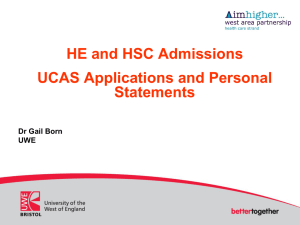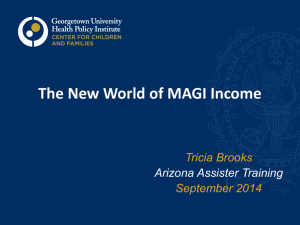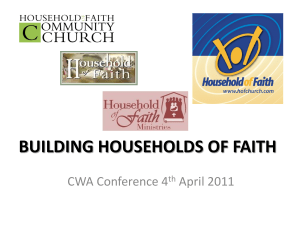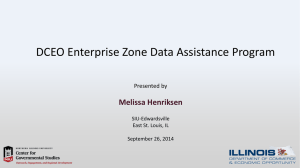ACA and MAGI
advertisement
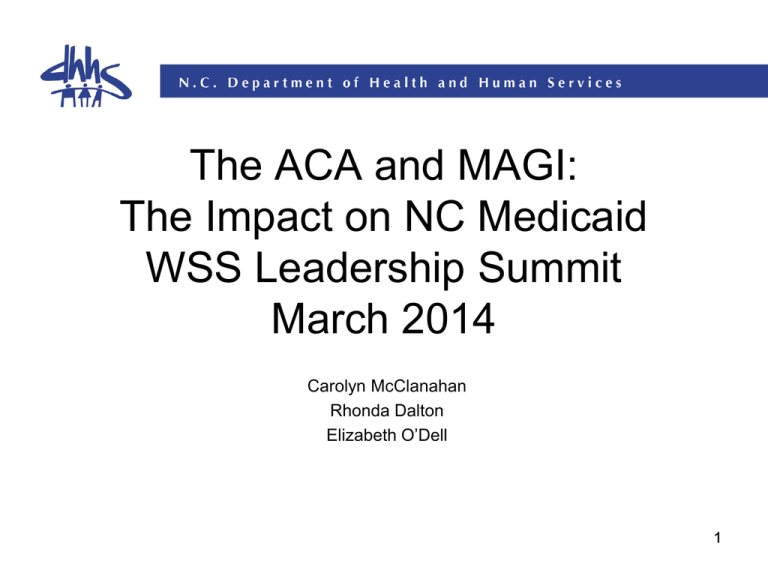
The ACA and MAGI: The Impact on NC Medicaid WSS Leadership Summit March 2014 Carolyn McClanahan Rhonda Dalton Elizabeth O’Dell 1 ACA in Review • ACA – Insurance Affordability Programs – – – – Medicaid NCHC Tax Credits (including Advance Payment) Cost-sharing • Open Enrollment – through 3/31/14 • To qualify for APTC or cost-sharing must be ineligible for Medicaid/NCHC 2 Overview of Changes • Pregnant Women Coverage – Client’s statement must be accepted as verification of pregnancy and due date unless there is a discrepancy – If an applicant is unsure of the due date, the County DSS must request information – Certification period for MPW is still the first month of eligibility through post-partum 3 Overview of Changes • Post-Eligibility for MAGI – Do not request verification of information on a noncustodial parent for IV-D prior to approving an application – Do not request third party insurance information prior to approving a Medicaid application – Do not require applicants to apply for all benefits to which they might be entitled, such as unemployment benefits or RSDI prior to approving an application • For UIB, if the applicant has not applied timely, do not count any phantom benefits. MAGI rules do not allow counting income that is not received 4 Overview of Changes • Former Foster Care Children (MFC) and Expanded Foster Care Program (EFCP) – The eligibility requirements for EFCP have not changed. – For EFCP, it does not matter what state he was in foster care at age 18. – For MFC, the child must have aged out of foster care in NC and been enrolled in NC Medicaid when he turned 18. – If a child is receiving EFCP and turns age 21, evaluate for MFC if all eligibility requirements are met. If not eligible for MFC, evaluate for all other Medicaid programs. 5 Overview of Changes • Electronic Verification – At application and review • Verification from an electronic source must be used first before requesting information from the client. • If the client provides an unsolicited verification of income that is more current, use that verification. • If a more current verification is in an active agency case file, use that verification. 6 FFM Applications • Date applicant applied at the FFM is the date of the Medicaid application – Will determine base period – Retro months – Ongoing months 7 FFM Applications • Submission date is the date the 45/90 day processing begins – Application processing rules have not changed • Applications must pend 45/90 days • If past 45/90 days must pend 2 DMA-5097’s 12 days apart. Can deny on the day following the expiration of the 2nd DMA-5097. 8 Example • DOA is Nov.15, 2013. DOS is Jan. 22, 2014. Received in the county March 2, 2014. – Retro = August, Sept. and Oct. – Ongoing = Nov. – Application has pended 45 days so the county will need to send 2 DMA-5097’s and deny on the 13th day after the second request 9 Example • DOA is March 12, 2014. DOS March 18, 2014. Received in the county March 20, 2014. – – – – Retro = Dec, Jan and Feb Ongoing = March 45th day = April 26, 2014 County will send 2 DMA-5097’s requesting needed information but case cannot be denied until due date of April 26. 10 FFM Applications • All applications prior to Jan.1, must be evaluated for traditional coverage – If evaluation results in ineligibility for any traditional program, it is not necessary to key a traditional application. – County should clearly document the MAGI streamlined application as if they were completing an inquiry and authorize to go to the FFM 11 Applications – April 1 and later • What happens on April 1? – Can still apply at FFM – If potentially eligible for Medicaid, application sent to NC – If ineligible, transfer back to FFM and will be evaluated for tax credits/subsidy, but cannot enroll in plan until open-enrollment in October 12 Applications April 1 and later • If client applies for Medicaid and is denied, account is sent to the FFM to determine eligibility for credit/cost-sharing, but cannot enroll in plan until open enrollment. • If an active beneficiary is terminated, account is sent back to the FFM for immediate evaluation 13 Applications April 1 and later • Certain situations allow for special enrollment period outside open enrollment – Loss of coverage, including ineligibility for continuing Medicaid/NCHC – Birth/death/marriage 14 MAGI • Modified Adjusted Gross Income Methodology • This is used to determine how income is counted and how household composition and a family size is constructed when determining eligibility for Medicaid/NCHC. • For Medicaid/NCHC purposes, the applicant’s countable income will be the “MAGI-based income. 15 MAGI Terms • Parent - Natural, adoptive, or step • Caretaker - Must have a child under age 18 in the household • Medicaid Aged Child - Natural, adopted, or stepchild under the age of 19 Note: Medicaid still covers under age 21, but they are not considered a Medicaid child in the household of a non-filer • Sibling - Natural, adoptive, or step • Family Size - Number in the MAGI household 16 MAGI Terms • Tax Filer • An individual who expects to file a tax return for the taxable year in which a determination is made for Medicaid/NCHC. • Tax Dependent • An individual expected to be claimed as a dependent by someone else • May also be a tax filer • Non-filer • An individual who is not expected to file a tax return or expected to be claimed as a tax dependent by someone else 17 MAGI Household • Each household member will have their own MAGI household • Individuals who live in a household may have a different family size • The family size will determine the income limit 18 MAGI Household • Under traditional budgeting the following individuals are not included in the needs unit but the MAGI household may include: • • • • • SSI Recipient CAP Recipient IAS WFFA Individuals under age 19 who: • Are or have been legally married • Are serving or have served in the military • Have been legally emancipated 19 MAGI ~ Household Composition 1 2 3 4 5 6 Will applicant/ beneficiary file Taxes? Yes Will applicant/ beneficiary file Taxes? No Will applicant/ beneficiary be a tax dependent for anyone else? Yes Does the applicant/ beneficiary meet any of the exceptions*? No Will applicant/ beneficiary file Taxes? Yes Will applicant/ beneficiary be a tax dependent for anyone else? Yes Does the applicant/ beneficiary meet any of the exceptions*? No Will applicant/ beneficiary file Taxes? No Will applicant/ beneficiary be a tax dependent for anyone else? No Will applicant/ beneficiary file Taxes? No Will applicant/ beneficiary be a tax dependent for anyone else? Yes Does the applicant/ beneficiary meet any of the exceptions*? Yes Will applicant/ beneficiary file Taxes? Yes Will applicant/ Beneficiary be a tax dependent for anyone else? Yes Does the applicant/ beneficiary meet any of the exceptions*? Yes Will applicant/ beneficiary be a tax dependent for anyone else? No Tax HH: HH is applicant, co-filer spouse and a/b’s tax dependents. Include live in spouse if not included in tax HH. Tax HH: HH is tax filer’s household claiming a/b as a dependent. Include a/b’s live-in spouse if not included in tax HH HH is applicant/beneficiary, spouse in the home, and their children in home under age 19. If applicant/beneficiary is under age 19: Also includes: live-in parent(s) and live-in siblings under age 19 20 *EXCEPTIONS: Is the Applicant: 1. A tax dependent of someone other than spouse or parent? 2. Under age 19 and living with both parents who will not file jointly? 3. Under age 19 and will be claimed by a non-custodial parent? Types of Medicaid/NCHC Households Tax Household – Used as Medicaid/NCHC when applicant is tax filer or tax dependent and not exceptions apply. The household includes: Tax Filer(s) Tax Dependents of Tax Filer(s) Spouse of applicant/recipient, if in the home and not in the tax household Non-filer household – Used when applicant/recipient is not tax filer or tax dependent or meets one of the exceptions. The household includes: Individual, and if living in the home: Individual’s spouse Individual’s natural, adoptive and step children under age 19 If individual is under age 19, includes same as above AND Individual’s natural, adoptive and step parent(s) in the home Individual’s natural, adoptive and step siblings in the home Pregnant Women NOTE: Under either type of household (tax or non-filer), when a pregnant woman is the applicant/beneficiary, always include the unborn(s) in her household when determining her eligibility for any MAGI program. When the pregnant woman is a household member of another applicant/beneficiary, include only the PW – do not add the unborn(s). 21 Clarifications • • • • Used for both applicants and beneficiaries Added “their” children under columns 4, 5 and 6 A spouse is a co-filer not a dependent When determining the hh of a pregnant women you include the number of unborn(s) • Spouse’s have to file jointly or separately • Under columns 2 and 3 the applicant’s hh is the same as the taxpayers. The taxpayer’s hh consists of the taxpayer, co-tax payer spouse and their dependents. Include live in spouse if not already included in tax HH. Include applicant’s live in spouse if not already in tax hh. 22 Counting Income Chart Counting Income Tax Household Tax Household Tax Filer(s) Tax Dependent – child of tax filer – does not meet an exception Count income of tax filer and co-filer spouse. Include live in spouse’s income if not already included in tax HH Only count income of tax dependents who expect to file a tax return. Count income of tax filer(s) Count income of the tax dependent applicant and other tax dependents who expect to file a tax return. Count the income of the tax dependent’s spouse if not included in the tax household. 23 Counting Income Chart Counting Income Non Filer Non-filer rules Tax Dependent – not child of tax filer (non-filer rules) Adult – age 19 or older Medicaid age child – under age 19 Count income for own household regardless of whether they expect to file taxes and count income of live-in spouse. If the tax dependent has children under age 19 in the household, count income of children under age 19 if they expect to file return. If the tax dependent is under age 19 ( see last column for Medicaid age child-under age 19) Count income of applicant and spouse, if in home. Count income of children in household under 19 only if expect to file return If parent(s) is not in the household count income for own household regardless of whether they expect to file taxes and count income of live in spouse and live in siblings under age 19. If the Medicaid age child has children under age 19, count income of children under age 19 if expect to file return. If parent(s) is in the household, count the income of the parent(s). Do not count income of the child and siblings under age 19 unless they expect to file a tax return. 24 Clarifications • Medicaid aged child under age 19 – If parent(s) is in the household, count the income of the parent(s). • Do not count income of the child and siblings under age 19 unless the child/siblings expect to file a tax return – Tax Dependent – child of tax filer – does not meet an exception • Only count the income of the tax dependent applicant if they expect to file a tax return 25 Example 1 • Caroline, age 19, is pregnant and has applied for Medicaid. She lives with her Mother, Teresa, who is divorced from Caroline’s father, and her 15 year old sister, Lucinda. There are no other siblings in the home. Caroline does not have any income and does not expect to file taxes herself, but expects to be claimed as tax dependent by her father, Carl, who also claims Lucinda. Lucinda does not expect to file taxes either. 26 Example 1 Caroline’s MAGI H/H: Caroline expects to be claimed as a tax dependent, but she does not meet any tax dependent exceptions. Column 2 corresponds to her situation. This means that her H/H will be the household of the tax payer who is claiming her – it will be her father, Caroline, her unborn child, plus any other dependents – Lucinda. Her family size will be 4. Caroline’s Countable Income: The counting income chart indicates that for the tax dependent who does not meet an exception, we will count the income of the tax filer – Carl. Lucinda’s MAGI- HH: Lucinda expects to be claimed as a tax dependent and she meets a tax dependent exception. Column 5 corresponds to her situation. This means that her H/H will be Lucinda, the applicant, and her mother, Teresa. Her family size will be 2. Caroline is over 19 and is not in her hh. Lucinda’s Countable income: Count the income of her live in parent Teresa. A P P L I C A N T Medicaid Household Caroline Lucinda Carl Caroline X+1 X X Lucinda X Teresa Family Size 4 X 2 27 Example 2 • Doreen is 16 years old and has applied for Medicaid along with her mother, Thelma, her father, George, and her 10 year old brother, Kevin. George and Thelma do not expect to file taxes nor be claimed as dependents. Doreen works and expects to file taxes, but does not expect to be claimed as a dependent. Kevin does not expect to file nor be claimed as a dependent. 28 Example 2 Doreen’s MAGI H/H: Doreen expects to file taxes and does not expect to be a tax dependent for anyone else. Column 1 corresponds to her situation. This means her household will consist of herself only. She is a family size of 1. Countable Income: The counting income chart indicates that for Doreen, a tax filer, we will count only her income when determining her eligibility. Kevin’s MAGI H/H: Kevin does not expect to file taxes nor expects to be claimed as a tax dependent. Column 4 corresponds to his situation. This means his household will consist of himself, his live in parents, Thelma and George, and his live in sibling under age 19, Doreen. Countable Income: His countable income will be Thelma, George, and Doreen’s countable income. Doreen is under 19 and expects to file a tax return. Thelma and George’s MAGI H/H: They do not expect to file taxes nor be claimed as a tax dependent. Column 4 corresponds to their situation. This means their hh will consist of Thelma, George, Doreen and Kevin. Family size of 4. Countable Income: Income of Thelma, George and Doreen because she is under 19 and expects to file a tax return. A P P L I C A N T Medicaid Household Doreen Kevin Thelma George Family Size Doreen X Kevin X X X X 4 Thelma X X X X 4 George X X X X 4 1 29 Example 3 • Rebecca is a single, age 22, and lives with her son, Jason, age 3. She does not expect to file taxes, but does expect that she and her son will be claimed as dependents by her mother and father, Claire and Clarence. There are no other dependents. 30 Example 3 Rebecca’s MAGI H/H: Rebecca expects to be claimed as a tax dependent and she does not meet any exceptions, therefore, column 2 corresponds to her situation. Her household will be the household of the taxpayer claiming her. This means it will include her mother and father (the tax payers), herself, and her son – a family size of 4. Countable Income: Rebecca is a tax dependent who does not meet an exception. The counting income chart indicates that we will count the income of the tax filers, Claire and Clarence. Jason’s MAGI H/H: Jason expects to be claimed as a tax dependent and meets an exception - he will be claimed by someone other than a spouse or parent. Column 5 corresponds with his situation. His hh will be Jason and his mother, Rebecca. Countable Income: Jason’s countable income will be his mother’s income only. A P P L I C A N T Medicaid Household Rebecca Jason Claire Clarence Family Size Rebecca X X X x 4 Jason X X 2 31 Example 4 • Cynthia, age 40, is applying for herself. She and her three children, Joseph 5, Mary 7, and Jacob 9, all live together in the home. She and the children’s father, Adam, are separated. Cynthia states to the caseworker “she does not expect to file a tax return but she expects that her husband will claim her and the children as dependents.” The children do not expect to file taxes. 32 Example 4 Cynthia’s H/H: Cynthia and her husband are still married. Spouses cannot claim a spouse as a dependent – they are co-filers which makes Cynthia a tax filer. Column 1 corresponds to her situation. Her household will be herself, her spouse/co-filer, Adam, and their three children whom they claim as dependents. A family size of 5. Countable Income: Since she is a tax filer, we will count the income of the tax filers which includes the co-filer, Adam’s income. It does not matter that he is not in the home since he is included in the tax household. Joseph’s H/H: Joseph does not expect to file taxes but will be claimed as a tax dependent by his father who does not live in the home. Joseph will meet a tax dependent exception - he will be claimed by a non-custodial parent. Column 5 corresponds to his situation. His hh will be himself, his mother, Cynthia, and his siblings Mary and Jacob. A family size of 4. Countable Income: His countable income will be the income of his live in mother, Cynthia. Mary and Jacobs’ MAGI HH and Countable income will be the same as Joseph’s. A P P L I C A N T Medicaid Household Cynthia Joseph Mary Jacob Adam Family Size Cynthia X X X X X 5 Joseph X X X X 4 Mary X X X X 4 Jacob X X X x 4 33 Recertifications • Recertifications – MAGI-based programs – Use traditional rules for recerts in 2014 – Keying: • Pilot counties – continue in P 2/6 • Non-pilot counties – continue in EIS – Complete recert application in P7 only if ineligible under traditional rules 34 Recertifications • EIS/NC FAST will automatically extend cert periods by one month if not terminated or assigned new cp (each month) • Oldest recerts worked first – EIS will create report monthly • Working with NC FAST 35 Questions? 36



